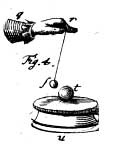This post (at long last) concludes my look at Simon Schaffer, “Experimenters’ Techniques, Dyers’ Hands, and the Electric Planetarium,” Isis 88 (1997): 456-483. To refresh yourself on the history of the electric planetarium experiment, see here; for further discussion of Schaffer’s interest in the role of manual technique in that history, see here.
—
 An important feature of Stephen Gray (1666-1736) and Granville Wheler’s (1701-1770) electric planetarium experiment was the claim that the revolution of a small, electrically charged object around a larger sphere might well illuminate the nature of the force that drives the planets in circular orbits around the sun. One obvious question—but one which Schaffer does not directly address—is how such a rudimentary and solitary experiment could credibly purport, even speculatively, to offer insight into such a grand and seemingly remote problem as planetary motion.
An important feature of Stephen Gray (1666-1736) and Granville Wheler’s (1701-1770) electric planetarium experiment was the claim that the revolution of a small, electrically charged object around a larger sphere might well illuminate the nature of the force that drives the planets in circular orbits around the sun. One obvious question—but one which Schaffer does not directly address—is how such a rudimentary and solitary experiment could credibly purport, even speculatively, to offer insight into such a grand and seemingly remote problem as planetary motion.
This, I think, is a question that forces us to think about the fundamental nature of early eighteenth-century natural philosophical inquiry. It is especially necessary to examine the distinctions and relations between experimental and speculative philosophy. On this distinction, also see the Otago philosophy of science group’s blog; but, where the Otago group tends to view experimentalism and speculation as different strands of philosophy, I would view them more as different facets of the same philosophical enterprise.
Read More…Read More…